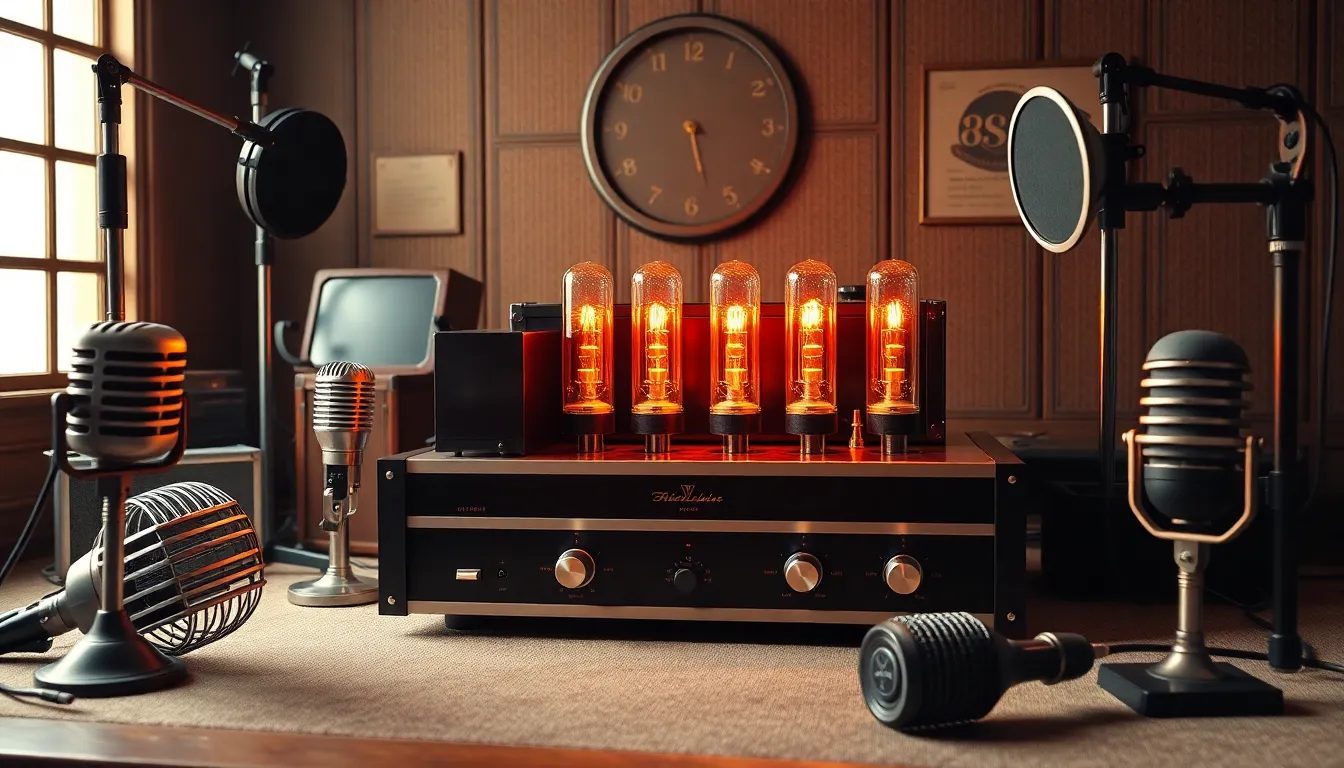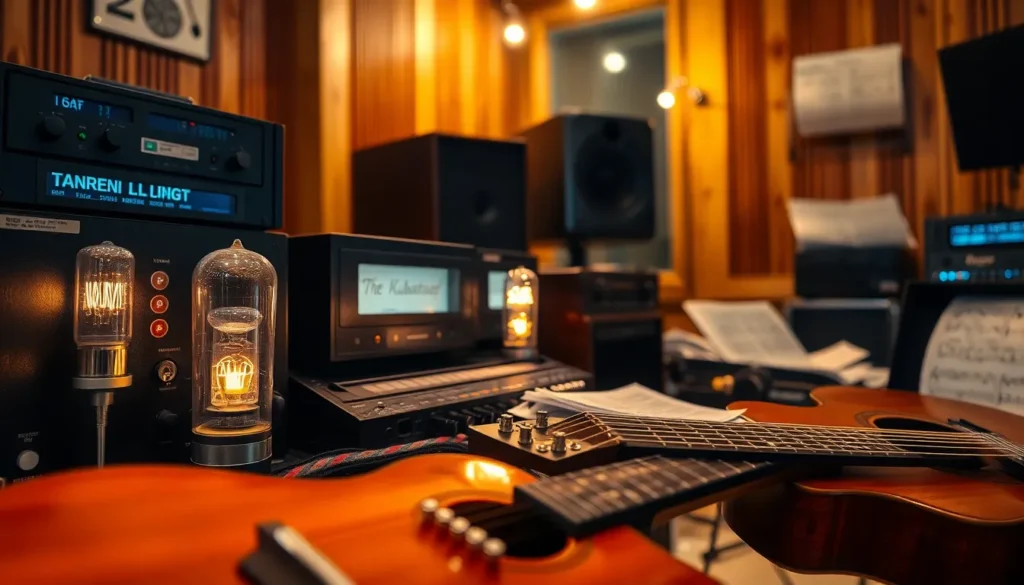In a world buzzing with digital gadgets and sleek devices, tube tech might seem like a relic from the past. But hold on to your headphones! This vintage technology is making a comeback, and it’s not just for hipsters sipping artisanal coffee. Tube tech offers a warmth and richness in sound that digital tech simply can’t replicate.
Table of Contents
ToggleWhat Is Tube Tech?
Tube tech refers to audio equipment that utilizes vacuum tubes for sound amplification. Unlike transistors, tubes generate a distinctive warmth in audio reproduction. This technology emerged in the early 20th century, becoming the standard until solid-state devices took over in the late 1970s.
Manufacturers recognize that tube tech offers a unique sonic quality characterized by harmonic distortion and dynamic response. Many musicians and audiophiles prefer tube amplifiers for electric guitars and high-fidelity audio systems. Sound produced by tubes typically resonates with a smooth, rich character, making it especially appealing for genres such as jazz and rock.
Tube tech operates by controlling the flow of electrons through a vacuum-sealed glass tube. This mechanism allows for intricate sonic manipulations, which can enhance musical nuances. Technicians often note that as tubes wear over time, they can produce even more pleasing sounds, attracting dedicated users.
Several brands lead the market in creating high-quality tube equipment. Companies like Marshall and Fender are known for their iconic tube amplifiers, favored by countless guitarists. Similarly, brands such as McIntosh and Audio Research excel in producing audiophile-grade tube preamplifiers that audiophiles appreciate.
In recent years, tube tech gained renewed interest, driven by nostalgia and a desire for more organic sound. Manufacturers innovate by combining traditional tube designs with modern technology. This blend enhances reliability while preserving the musicality that tube enthusiasts cherish.
History of Tube Tech

Tube technology originated in the early 20th century, transforming audio amplification. This innovation laid the groundwork for rich sound experiences.
Early Innovations
Early vacuum tubes emerged in the 1900s and revolutionized electronics. Innovators like Lee De Forest introduced the Audion tube in 1906, enabling the first stages of audio amplification. Engineers quickly recognized that tubes could enhance sound quality beyond the capabilities of existing technologies. Utilizing this advancement, radio broadcasts flourished, and musicians began to explore tube amplifiers for live performances. The marriage of vacuum tubes and sound marked a significant departure from mechanical systems, paving the way for an unprecedented sonic landscape.
Evolution Over Time
The technology saw widespread adoption during the 1920s and 1930s in radio and recording studios. As the audio industry grew, tube technology dominated until the rise of solid-state devices in the late 1970s. Many musicians favored tube amplifiers for their warmth and dynamic range, despite the convenience offered by transistors. Tube designs continued to evolve, with brands improving reliability and sound quality. This era witnessed the creation of iconic amplifiers, like the Fender Twin Reverb, which defined genres such as rock and jazz. Nostalgia for the tube sound also propelled a resurgence, as manufacturers innovated while maintaining the charm that originally captivated audiences.
Applications of Tube Tech
Tube technology finds unique applications across various fields. Its distinct qualities appeal to audio enthusiasts, medical professionals, and researchers alike.
Audio Equipment
Music producers and audiophiles highly value tube-based audio equipment. Vacuum tubes provide a warm and rich sound that solid-state devices often can’t replicate. Electric guitar amplifiers from brands like Marshall and Fender demonstrate this quality, producing harmonically rich tones preferred by musicians. Likewise, high-fidelity audio systems from McIntosh and Audio Research cater to listeners seeking deep, nuanced sound. Such sonic characteristics enhance genres such as rock and jazz, making tube tech a staple in professional and home audio setups.
Medical Devices
Medical imaging equipment benefits from tube technology as well. Imaging systems like X-ray machines use vacuum tubes to create detailed images, providing crucial diagnostics for healthcare professionals. These devices operate effectively in various medical settings, enabling accurate patient evaluations and treatment planning. Moreover, certain therapeutic equipment leverages vacuum tubes to deliver targeted radiation treatments. This technology ensures precision and efficacy, underlining its vital role in modern healthcare applications.
Scientific Research
Researchers utilize tube tech in scientific exploration. Vacuum tubes serve as essential components in particle accelerators and other experimental setups, allowing precise measurements and data collection. Scientists rely on this technology for its ability to amplify weak signals, crucial for detecting subtle phenomena. Additionally, tube amplifiers often find use in laboratory equipment, enhancing signal quality in sensitive experiments. Overall, the versatility of tube technology supports advancements in diverse scientific fields, driving innovation and discovery.
Advantages of Tube Tech
Tube tech offers numerous advantages, particularly in sound quality and durability. These qualities make tube technology a go-to choice for many audio enthusiasts and professionals alike.
Sound Quality
Sound quality stands out as a primary advantage of tube tech. This technology produces a warm, rich sound that many find appealing, especially in genres like jazz and rock. Harmonic distortion also contributes to a musical character that enhances overall listening experiences. Musicians appreciate that tube amplifiers respond dynamically, emphasizing nuances in performance. Genres benefit from the smooth sustain and complex overtones that tubes provide, creating a more immersive soundscape. Many audiophiles prefer tube equipment for high-fidelity systems, firmly believing it captures audio in ways solid-state devices simply can’t.
Durability
Durability plays a significant role in the appeal of tube tech. Although tubes may eventually require replacement, their lifespan can be impressive. Users frequently notice that aging tubes can deliver even more pleasing sounds over time, adding to their allure. Tubes handle the rigors of performance settings well, making them suitable for traveling musicians. Furthermore, innovative manufacturers design modern tube amplifiers to enhance reliability without sacrificing sound quality. Users value the craftsmanship evident in tube equipment, which often leads to lasting investments. Many see that the longevity and performance of tube systems affirm their continued existence in a technology-driven world.
Disadvantages of Tube Tech
Tube technology offers exceptional sound, but some disadvantages exist. Awareness of these drawbacks helps consumers make informed decisions.
Cost
Tube equipment typically costs more than solid-state alternatives. High-quality components and craftsmanship contribute to elevated prices. For instance, premium amplifiers can range from $1,000 to over $5,000, depending on brand and specifications. Musicians seeking budget-friendly options face limited choices in the tube market. Additionally, replacement tubes incur ongoing expenses. Quality tubes can cost between $20 and $300 each, impacting overall affordability. Some users may find these costs justifiable when considering sound quality, but price remains a notable factor.
Maintenance
Maintaining tube gear requires more attention than solid-state devices. Regular inspections ensure optimal performance and longevity. Users must be prepared to replace tubes periodically, typically every few months to years, depending on usage. Aging tubes may lead to degraded sound quality and inconsistent performance. Investing in skilled technicians for repairs or modifications becomes essential. Maintenance costs can vary, with some repairs reaching hundreds of dollars. While many enthusiasts enjoy caring for their equipment, this commitment may discourage casual users.
Future of Tube Tech
Technology trends indicate a promising future for tube tech in audio applications. Emerging brands continue to innovate, infusing modern features into traditional designs. The blend of tube warmth with digital precision enhances overall sound quality, making tube models increasingly appealing.
Consumer interest in vintage sound provides a fertile ground for growth. Brands like Marshall and Fender are reimagining classics, creating contemporary amplifiers that resonate with both new and seasoned audiences. The integration of smart technology into tube amplifiers also enhances user experience, facilitating seamless connectivity with modern devices.
Manufacturers are prioritizing sustainability as they develop tube equipment. The focus on using longer-lasting materials results in reduced waste and longevity in performance. Enhanced durability brings peace of mind to musicians and audiophiles alike, knowing their investment can withstand the test of time.
In the realm of medical technology, tube tech shows no signs of waning. Advancements in diagnostic imaging systems leverage vacuum tubes for superior resolution and accuracy. Hospitals and laboratories increasingly rely on the unique capabilities of tube tech for critical applications.
While challenges exist, such as cost and maintenance, creative solutions are emerging. Manufacturers are exploring more efficient production methods to bring prices down. User-friendly maintenance guides and kits simplify upkeep tasks, making tube equipment more accessible for casual users.
As the landscape evolves, the nostalgia associated with tube technology remains powerful. Celebrating its rich history, enthusiasts are eager to explore its future possibilities. The commitment of both consumers and creators ensures that tube tech will retain its place in audio and beyond, proving its resilience in a rapidly changing technological world.
The revival of tube technology in audio equipment signals a renewed appreciation for its distinctive sound quality. As musicians and audiophiles seek warmth and character in their audio experiences, tube tech stands out as a compelling choice. Its unique ability to enhance musical nuances continues to captivate a diverse audience, bridging the gap between nostalgia and modern innovation.
Beyond audio, tube technology’s applications in fields like medicine and research showcase its versatility and enduring relevance. While challenges exist in terms of cost and maintenance, the ongoing commitment to innovation ensures that tube tech will remain a vital part of various industries. As consumers explore its future possibilities, tube technology is poised to thrive, blending tradition with contemporary advancements.




